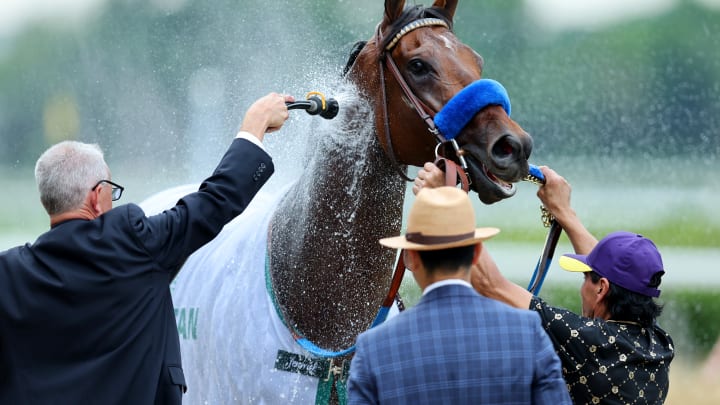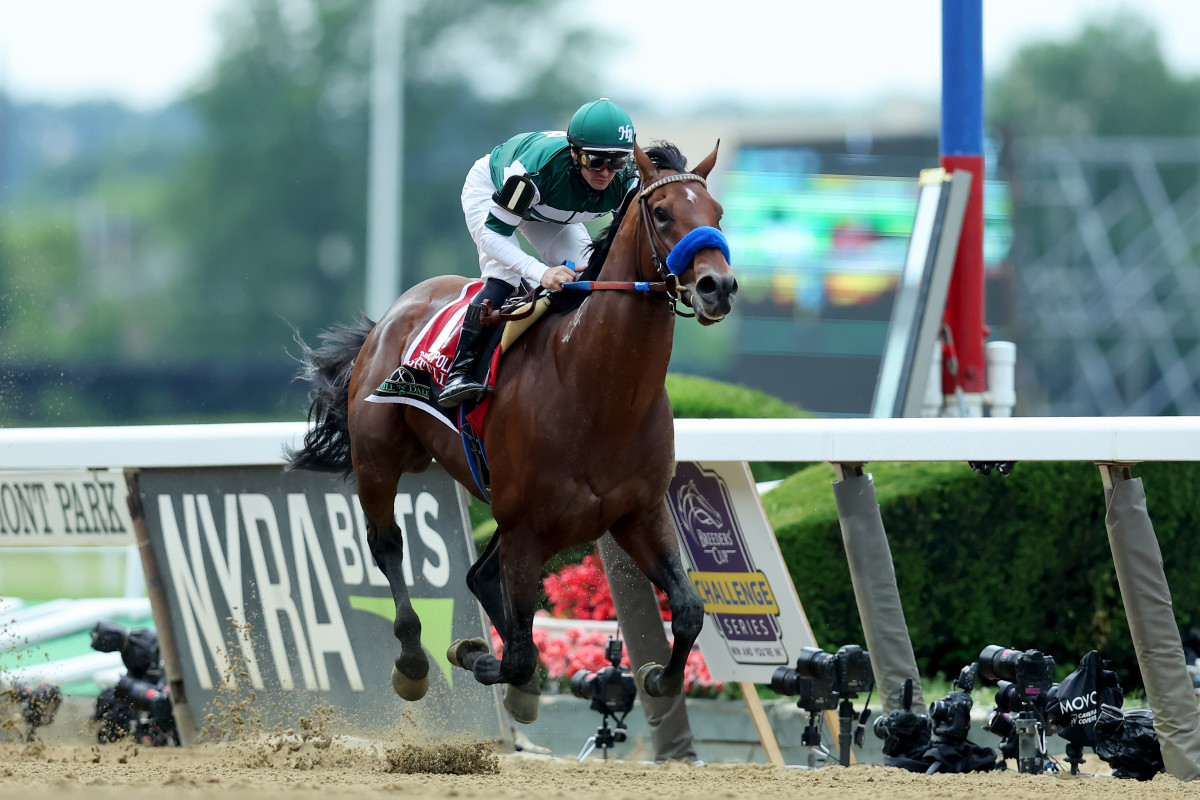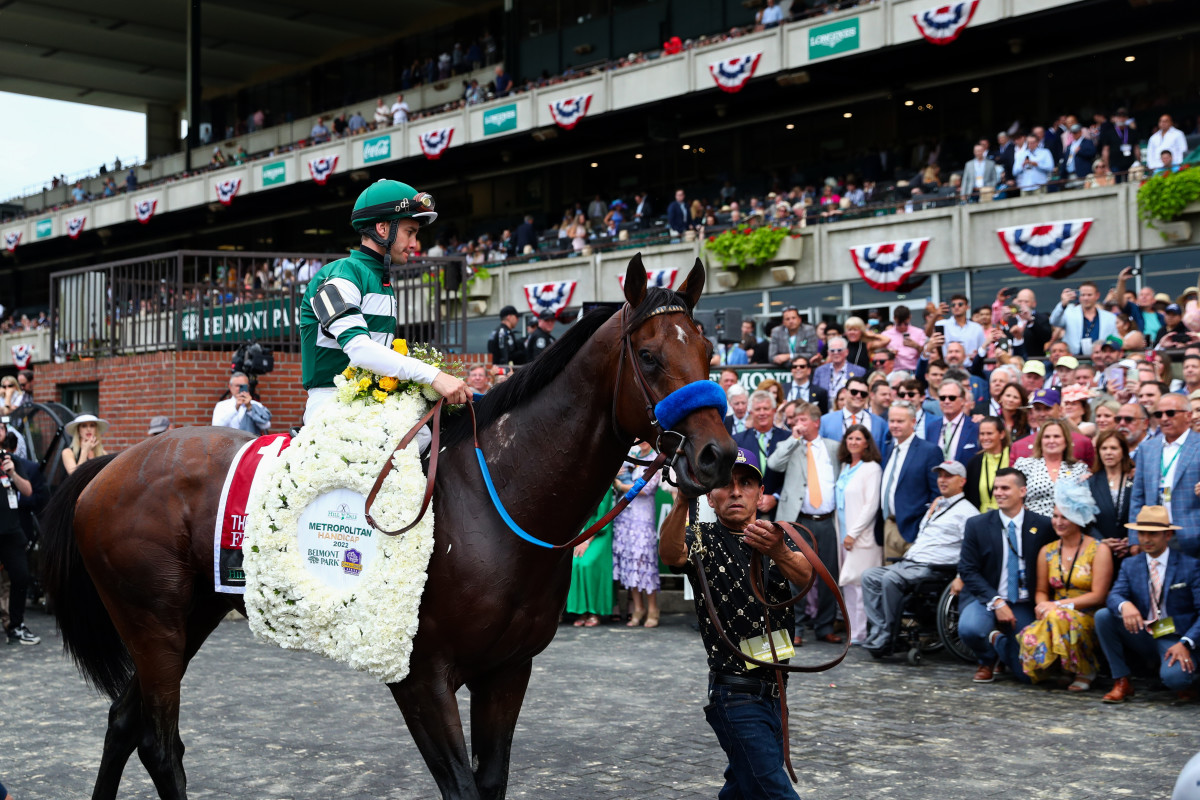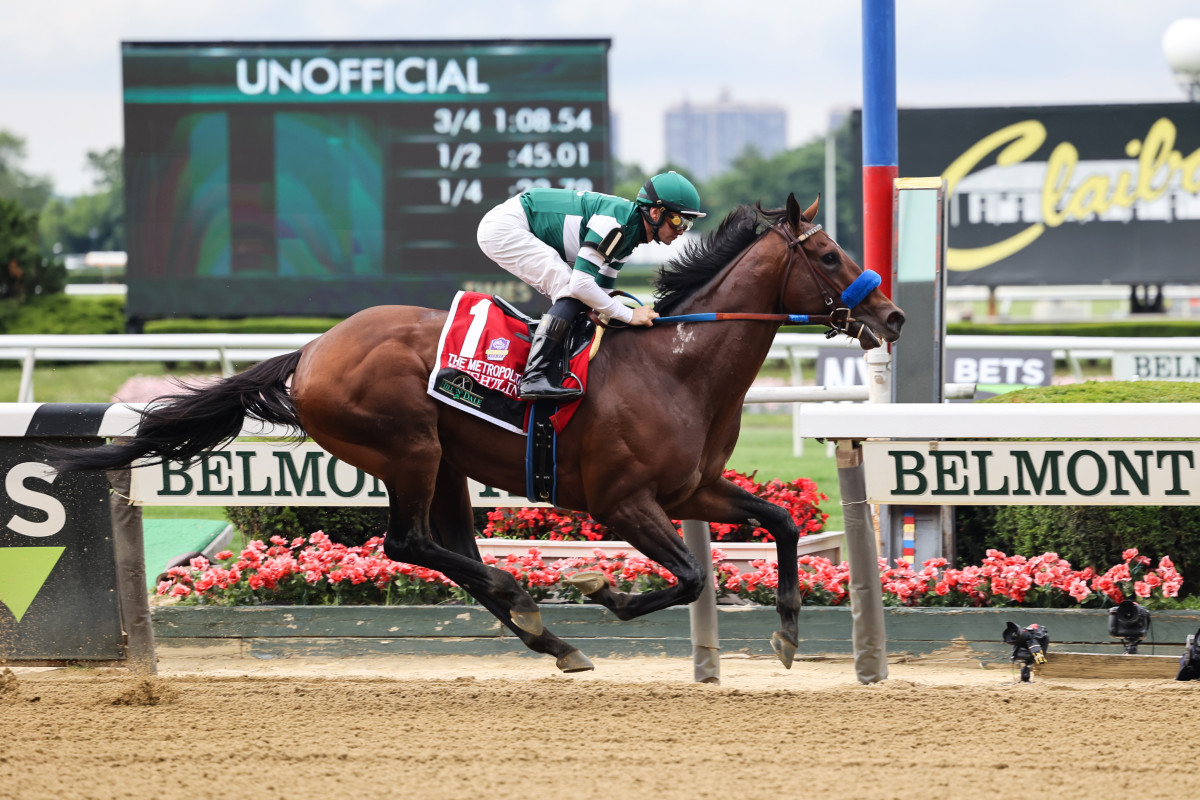Meet Flightline, the Greatest Horse You Never Heard Of

[Editor’s note: Flightline won Saturday’s Breeders’ Cup by eight-and-one-fourth lengths, taking a commanding lead on the final turn and down the stretch, as is his strength. Here is the story behind arguably one of the greatest thoroughbreds of all time.]
Outlined against an orange-pink October sky, the horseman rode again. Juan Leyva, the only exercise rider for perhaps the greatest American racehorse of the 21st century, spurred his mount from a trot into a gallop at the five-eighths pole on the Keeneland Race Course backstretch and was gone.
The sunrise that was painting the eastern sky had not cleared the grandstand, so after a while the only reliable evidence of the steed’s progress was the flickering red safety light on Leyva’s helmet. The light was moving quickly.
“When he comes back around, it will be a holy mackerel moment,” said West Point Thoroughbreds vice president Jeff Lifson, who has been around the horse since his purchase as a yearling in 2019, as he provided narration for the video he was recording on his phone.
Sure enough, Leyva was carried back around the turn by a bay-colored horse still full of run, galloping out strongly and smoothly after a five-furlong workout—power and speed hidden beneath a seemingly effortless stride. That was the final major effort before the biggest race of the animal’s life. Probably the last race of his life, too.
When that workout was complete, it was all systems go in the Breeders’ Cup Classic for Flightline, the best horse you’ve never heard of. A 4-year-old who missed the Triple Crown campaign of 2021, he’s produced five victories of mythic proportion. Now the moment is at hand Saturday in Lexington, Ky., for both his grand introduction and final validation. Hello and goodbye, perhaps, all at once.

For the first time in his short racing career, Flightline will be on live national network television. NBC will carry the BC Classic at 5:40 p.m. ET, giving a mainstream audience a chance to glimpse an undefeated monster who has won his five races by a combined 62 1/2 lengths. He is the 3-5 favorite, prohibitive odds against a Classic field that always is the strongest of any race in a calendar year, but seems to be overmatched here.
“He’s apt to prove himself much the best Saturday,” says Andy Beyer, one of the foremost authorities on American racing, the namesake and creator of the Beyer Speed Figures that have become the most widely used metric in handicapping. “I expect him to win. I’m hoping for a blowout, and he’ll be on a fairly short list of the best horses we’ve seen in a long time.”
By “a long time,” Beyer means half a century or more. He takes it back to the racing golden age of the 1970s, listing immortals Secretariat, Seattle Slew, Affirmed and Spectacular Bid—three Triple Crown winners and a fourth (Spectacular Bid) who won two legs. They transcended the sport’s niche audience, becoming the stuff of books and movies and folklore.
“They’re the benchmark you’d compare horses with,” Beyer continues. “I picked Flightline [in the Classic] and expect to have his name mentioned in the same breath with some of those legendary horses.”
Understand the 78-year-old Beyer has seen enough to not be prone to cheap hyperbole. But still: That kind of praise skirts the border of sacrilege—Secretariat, Seattle Slew, Affirmed, Spectacular Bid … Flightline?
Watching his races to date, it’s hard not to feel a similar sense of awe. Flightline possesses natural speed to assert himself early in races and then has a high cruising motor and staying power that allows him to draw off for awe-inspiring margins of victory.
“It’s almost impossible to describe how you feel when you see your horse just moving past the competition and just keep on going,” says Flightline’s breeder, Jane Lyon of Summer Wind Farm, who also owns a percentage of the horse. “It’s something like a dream.”
A dream to watch, and a horse with numerical substance to back the hype.
(Here it’s probably time for a brief explainer of the Beyer Speed Figures, which became nationally established in the early 1990s. They are assigned via mathematical formula by the Daily Racing Form for races across the nation, factoring in time and how fast [or slow] a track’s racing surface is playing that day. There is more nuance to it than simply looking at a stopwatch and spitting out a number for each horse.)

Flightline’s average Beyer Speed figure for his five races is 115—a number that no other horse in the Classic field of eight has produced on their very best day. His top speed figure—126 in the Pacific Classic, his most recent race—is the stuff of legend.
The only higher number by an American horse in the 21st century was from the great Ghostzapper in 2004, when he recorded a 128 in what Beyer termed “semi-flukey circumstances.” It was a muddy track in a low-profile race at Monmouth Park.
Ghostzapper did back that up with a 124-speed rating in winning the Breeders' Cup Classic later that year, marking him as the one horse in the last two decades that some will rank ahead of Flightline (pending Saturday). Recent Triple Crown winners American Pharoah (2015) and Justify (’18)? Nope. Neither of them touched Flightline’s Pacific Classic number in any of their races.
(Other handicapping metrics are similarly huge for Flightline from that race. The Timeform and Thoro-Graph ratings both make it an all-time great performance. Timeform says his Pacific Classic made him “the highest-rated American-trained horse” in its 29-year history. Thoro-Graph rates that race higher than any in its 35-year history.)
“When the Pacific Classic was run, it really confirmed how good Flightline is on a historical spectrum,” Beyer says. “I wish the jockey [Flavien Prat] had ridden for history and pushed him a little harder at the end, gone for a 130 [Beyer figure].”
So where did this obscure superstar come from?
Flightline’s arrival at the racetrack was delayed, but he is no underdog story. He was literally born for this. The well-bred son of prodigious sire Tapit fetched a hefty $1 million auction price at a yearling sale at Saratoga in New York in August 2019. He was sold to bloodstock agent David Ingordo, who did the bidding on behalf of West Point Thoroughbreds (president Terry Finley), Hronis Racing (Stephanie Hronis) and three other partners.
Flightline was sent to California-based trainer John Sadler, who won the 2018 Breeders’ Cup Classic with Accelerate. Sadler is an accomplished conditioner but never afflicted with the well-known malady Derby Fever—he’s not been prone to pushing young horses onto the Triple Crown trail before they are ready.
Still, the path into and out of the Triple Crown campaign is littered with 3-year-olds who are campaigned with the sole goal of taking a swing at those big-dollar, big-spotlight races. Why didn’t Sadler, with a horse of clear and abundant talent, try to get Flightline more into the action at age 3?
“Because I know better,” the 66-year-old says. “If you take care of the horse, they take care of you. … We let the horse lead us. We try to be good stewards with him, because he’s got such talent.”

In Flightline’s case, the biggest reason for moving slowly is visible on his right hind end. A large, L-shaped scar traces where stitches were needed to sew up a gash suffered when he backed into a stall latch at age 2—a wound that took about three months to heal. That and some other minor injuries kept him off the Triple Crown trail, which usually begins in the latter months of a horse’s 2-year-old season (which for Flightline was 2020).
He didn’t race until April 24, 2021—one week before his 3-year-old class contested the Kentucky Derby. Despite being unraced, his sharp morning workouts and breeding established him as the 4-5 favorite in his debut, and Flightline delivered with a 13-length romp in a six-furlong race. “His name is Flightline, and he is long gone,” Santa Anita track announcer Frank Mirahmadi said, presciently adding, “a potential star here.”
But a foot abscess slowed summer plans, keeping Flightline out of the high-profile post–Triple Crown races on the East and West Coasts in July and August. Flightline didn’t race again until September 2021. When that race at Del Mar in San Diego turned out the same—a 12 3/4-length blowout—the industry started to take serious notice, and Finley felt himself unexpectedly moved.
“We’ve been doing this for over 30 years, had nearly 6,000 starters, but he struck a chord that day in me,” Finley says. “I was overcome with emotion. I know he ran fast, but something about him—the degree of effortlessness just takes your breath away. He’s so spectacular, he gives you the impression like, it ain’t no big deal.
After that, it was time to hunt bigger game. In the Malibu Stakes, a Grade I race the day after Christmas, Flightline again made a mockery of the field. Still plotting a patient path into 2022, a minor foot problem kept Flightline out of the San Carlos Stakes in March. Plan B was shipping across country to Belmont Park in New York for the Met Mile in June. A slow break and some early racing traffic provided Flightline his first hint of adversity. It didn’t last long; he asserted himself on the turn and again won going away.
That led to the tour de force in the Pacific Classic. It was Flightline’s longest race—1 1/4 miles, same distance as the BC Classic—and his largest margin of victory yet at 19 1/4 lengths.

Now Flightline is in Lexington—bedrock horse country and not far from where he was bred—trying to win a $6 million race and firm up an exalted place in the sport’s ancient history. It will almost certainly be his last race, because there is a towering pile of cash to be made in the breeding shed, but Finley will say only that the ownership group has a meeting scheduled for Sunday to discuss next steps.
Before then, in the pitch-black Saturday morning, around 3:30, Sadler’s barn foreman will perform the daily ritual with Flightline. He will lead him out of his Barn 60 stall—the one with the blue gymnastics-style padding on the walls, because the horse likes to rear up and kick—for a stroll.
The routine stays constant, no matter where Flightline is stabled at the moment. Back home at Santa Anita, there is one spot in that pitch-dark stroll where they say Flightline likes to stop and look at the sky. Since arriving in Lexington the nights have been clear, excellent for gazing at the heavens, and that’s the forecast for the wee hours of Saturday as well.
Flightline can examine the stars one last time before taking his place among them, a hello-goodbye moment on stage for the greatest horse you’ve never heard of.
